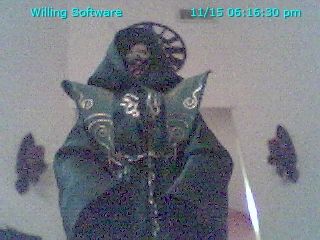Jeffery Douglas Interview
Author notes: - I originally contacted Jeffery back in 2001 after tracking him down in a rather obscure piece of the internet. As you will see from the interview, Jeffery had distanced himself from all things WorldsAway after leaving Fujitsu. It was by sheer luck I was able to find an email address for him and that he answered. He agreed to chat to me back then but it wasn't until 2005 we were able to put anything together. Real life conspired against us for a while. I think you'll agree however, it was worth the wait.
This interview was originally published in the Virtual Planet newspaper as part of the 2005 10 year Anniversary celebrations. It has been out of print since VZones originally closed in 2014 and the Virtual Planet newspaper went offline.

How did your position as Producer of the Dreamscape come about?
In the early 1990s, I was working at Logitech in the Entertainment and Virtual Reality (EVR) group for James Barnes and Joseph Pinzarrone, doing evaluations of VR hardware such as head-mounted displays and wireless controllers and the like. One day while reading one of the cyberspace newsgroups, I came across a job listing for a writer on an online virtual world product. (Honestly, it has been so long I don't recall how the product was described.) The job entailed creating the backstory and mythos for this new virtual world being created by Fujitsu Cultural Technologies. I wasn't a writer, but my wife (now ex-wife) Maria Alexander was. So I passed it along to her and she was hired to create the cohesive storyline for the Dreamscape. She created and used the character of the storyteller Alayne as her device.
In 1994 the EVR group was shut down, despite producing one of Logitech's most successful line of products, the Wingman joysticks, and I found myself looking for my next job. A few months later, Maria told me about a job at Fujitsu for a helper and world guide. I can't recall if the job title was "Oracle" at that point or not. It very well could have been. I had "Oracle" as the title on my business card for a long time. I do remember there was a debate as to whether or not the volunteer helpers were to be called Acolytes or Docents (or some other mundane term). Randy believed in Maria's mythology, as did I, and I didn't even know what the hell a "docent" was. So Acolyte triumphed.
While I didn't have direct experience managing a community (I don't even think the job title "community manager" existed then), I had 4 years of technical support and customer service under my belt (including managing bulletin boards), more than a year working on cutting-edge VR software and hardware, and 5 years running my own company creating and running live action roleplaying games. So I had a pretty good handle on managing interactive stories, people and problems.
In any case, I interviewed with Tony Christopher (who was either Director or VP of MarCom at the time), Paul Taylor (who ran the customer service team) and Randy Farmer. I remember Randy being a very good interviewer. His technique focused on one's ability to arrive at an answer versus the person already knowing the answer. My second interview with him was a walk along the levee behind Fujitsu, and was more of a conversation. I don't even think I knew I was being interviewed. It seemed his primary concern was about the candidate's ability to adapt or evolve along with an object-oriented world that could be manipulated (and hacked) by customers.
One of his benchmark tests was the Checkers Conundrum. The goal: put the game of checkers in the world. The problem: How do you deal with the countless variations of rules? The answer: don't code any rules. Let the players decide on the rules and enforce the rules themselves.
(Actually, the laws of the Dreamscape were built on a foundation of self enforcement. At least to the extent possible, and balanced with the realities of having to run a business. More on that later...)
I guess I got the answers correct to his satisfaction, because I started as an Oracle in October of 1994. The only problem was, there was no community for me to manage. When I came on board, almost immediately the product was delayed. I don't recall why, but there was no question it wasn't ready. I was picking up tasks here and there, doing research, but not really doing what I was hired to do. I remember Randy coming to me and telling me I was brought on too early.
This was a very good thing.
Instead of telling me to go away and come back in 3 or 6 or 9 months, Randy began teaching me everything I needed to know about running the Dreamscape. He taught me how to design the world map and why certain things should be placed in certain places. He explained the decisions behind things like implementing teleporters versus having to walk places. He taught me what would make a good Acolyte and what would make a good beta tester. I kept gobbling it up and he kept handing me more and more stuff to do. Pretty soon, I wasn't a community manager, I was a world designer. After that, I was a product manager. Finally, I became the producer. But I left "Oracle" on my business card until I became Producer.
If it hadn’t been for Randy taking the time with me back then, I wouldn’t have a career in communities today. You can trace a line through everything I’ve done directly back to him.
Right or wrong, there was a conscious decision to do the things we did in the world. There was a reason you had to walk to an ATM, or that different Pawn machines paid out different prices. Back in the mid 1990s, there weren't a lot of "best practices" or "lessons learned" documents floating around. As far as I knew, the only people who had done this stuff before were Randy and Chip Morningstar (and Oracle Layza from Japan). The boys were on contract with Fujitsu, but Chip was leaving to work full time on Electric Communities. Randy stayed behind longer than intended just to help launch WorldsAway.
Were you hired after Electric Communities Randy Farmer and Chip Morningstar were creating the software or were you only hired once the world was in its initial beta stage?
I was hired near the end of their contract. In fact, their initial contract had probably lapsed and they were on extensions.
The WorldsAway technology existed (and was in alpha) when I was hired, as did the backstory. Artwork for the world existed, but not in a usable form. The world map did not exist. When I arrived, Randy was working 100% on WorldsAway (codename: Reno), Chip was working half time (rapidly reducing to no time). My time with Chip overlapped only slightly. Douglas Crockford was working full time on developing the Electric Communities business plan and waiting for Chip and Randy to break free. (Thanks to Randy for filling in my sketchy memory here!)
I created the original Dreamscape regions by hand using a pencil, graph paper and trial and error. I had to recompile my test world every time I wanted to move stuff around. Jeff Crilly and Norman Morse were my heroes. Jeff developed the devClient and Norman developed fiddle. Norman and I hold the patent for fiddle (US Patent #5802296 - Supervisory powers that provide additional control over images on computers system displays to users interactings via computer systems). I did all the updating of the world on John Onusko's Sun system, Akasha. John was like a god to me - he was brilliant and helped me out whenever I needed it. He would come into The Cave (the former server that served as the art room and Oracle room with all the fluorescent lights off), we'd brainstorm and the next day he would have added some desperately needed feature.
There were multiple permission levels for an avatar: Avatar, Acolyte, Oracle and Dog. If you had the dog bit flipped, you could do anything in the world. The dog bit was created by John, after his avatar name, Surfdog. Five years later, after joining There, I was looking through the code for that product and found that the permission bit for in-world helpers was called the Acolyte bit.
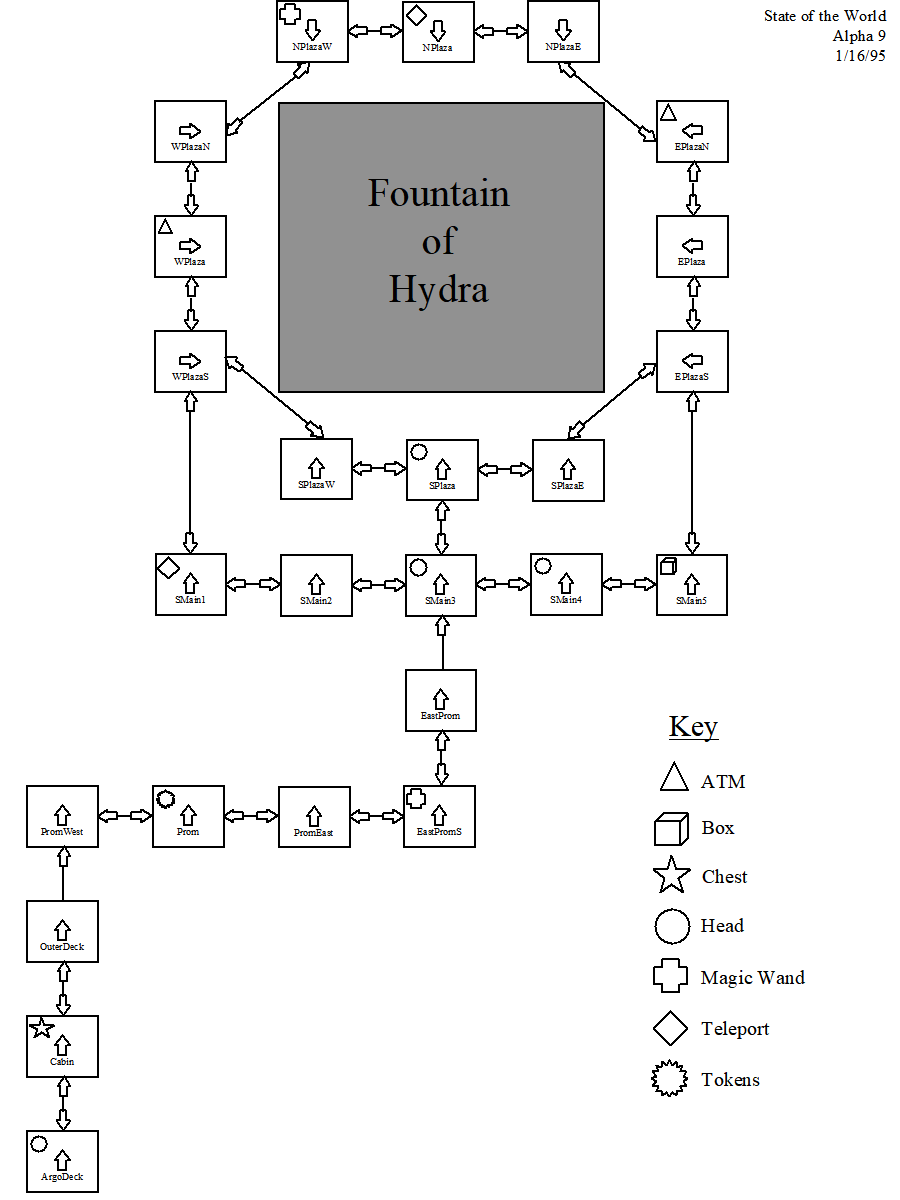
I'd like to talk about what was originally planned for Dreamscape, I have heard rumours that were to be things such as Magic spells and that you could kill people like in Habitat. What was the original story for the world? and were there characters and events we never heard about but they were planned
Those aren't rumors, those are facts. Spells were a big part of the world as originally conceived. As were curses. These were created by Randy and Chip: An avatar becomes cursed by finding a planted object and can only become uncursed if she touches 5 other avatars that haven’t already been cursed. There were also cures and other variations on the theme. That was a major part of the interaction I wish we could have experienced.
I don't believe killing was ever seriously considered, at least for Dreamscape. The idea of being able to affect another avatar was in the design, as were permission bits for when and where that could happen.
When the Bar-L Bar opened, there was a locked chest inside that had an Asian Opera head in it. The chest originally had a combination lock on it, but we were told the combination lock class was not secure, so it was changed to a regular keyed lock. I had always planned a quest for the combination but it was never fixed and I never got around to it.
The attached World Plan shows to some extent some of the objects and interactivity we had in mind.
The original story of The Dreamscape is complex. It involves the god Morpheus and his brothers Phantasus and Phobetor. Morpheus gets bored and decides to leave humanity, inviting his brothers to go away with him. Phantasus is bad and Phobetor is worse. They plot to seal Morpheus in the Dreamscape and take over humanity. Morpheus discovers the plot and gathers his Oracles and followers and away they go to the Dreamscape where Morpheus creates the island of Kymer and they live happily ever after.
From Brothers, by Maria Alexander (used with permission)
"The Dreamscape contains one major continent, known as the Plains of Nyx, and the island of Kymer. Separating the two land masses is the Sea of Io, who shelters a number of smaller, uncharted islands in her cold arms. The Plains of Nyx are where we humans go in our sleep to dream; many parts of Nyx are quite beautiful, but thanks to mischievous Phobetor, all sorts of terrible beasts roam these plains, namely Nightmares and other, more horrid, creatures with unmentionable features and unspeakable purposes. Humans are the only other beings allowed to enter the Plains so that they can search for their dreams each night.
Kymer is, on the contrary, a wholly blessed island, protected by Morpheus from any sort of danger. Morpheus detests Nightmares and all such under the rule of Phobetor, so none are to be found in Kymer."
The city of Phantasus is named after, well, Phantasus. There were plans for Oracles of Phobetor to arrive and begin a war. The Blasted Heath was to be the land of those who worshipped Phobetor. One of the original plot points was the introduction of the Nightmares. The flaming hoof print objects were created but never used. The hoof prints were to show up inexplicably over night, ushering in a time of battle between the gods that engulfed the dreamers.
There is a secret history of Oracles. Only a handful of people knew it. Probably, only a few remember it. Likely, only two of us still have the document.
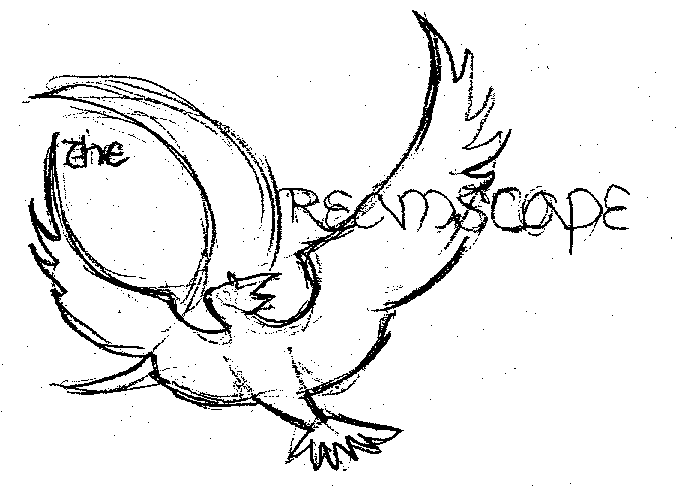
How different was the Dreamscape in its first few weeks of production than the Dreamscape that was released to the public?
Well, there was no Charles Faulter, PhD, no Void, no aliens and no way to customize the color of your clothes. There was no newspaper, but the Kymer Clarion didn’t take long appear. There were very few objects in the world, almost all of which were knickknacks. But the biggest difference, at least in terms of being a service provider, is that the Acolytes had no powers! All they could do was use the persuasive force of their typing skills (a.k.a. “the wagging finger”). The only power the Oracles had was permanent banishment, so problems tended to get resolved immediately, else they went nuclear real fast.
Eventually the Acolytes got their books (object class: Amulet) and Oracles got their staves (object name: Fiddle), and all was good in the world.
To overcome the problem of everyone looking the same, we invented The Oil of Okay, which was an Oracle staff in the shape of a jar of ointment. We created the characters of Charlotte-N and Yul Brenner who held paint days. People lined up for hours while they painted clothes. This solution obviously wasn’t scaleable, so the paint can was created so people could paint themselves. However, there was still a desire for Charlotte-N and Yul to paint, because they could paint any color in the color palette, as they had dog powers. I was Charlotte-N.
The first accessory created was a pair of glasses. They didn’t fit right. So I gave them to Randy Farmer’s incognito avatar, along with a Tell Me About of “Trust Vaz”. Well, having the only pair of glasses in the world made him pretty popular, pretty fast. Soon, people were clamoring for accessories. So we bumped them up on the schedule. This was one of the underhanded ways we got things done back then – introduce a broken copy and tell management the customers are going out of their skulls because of it.
Some people thought we were great, some people thought we were blowing it. We tried very hard to make sure there was a reason (even it was a goofy one) for whatever we introduced into the world.
Here is the Dreamscape Rollout Schedule, as reflected in an email from me to Tony Christopher on 30 July 1997:
Dreamscape Timeline
- 8/95 - 0.8 Released
- 8/95 or 9/95 - BodySpray introduced
- 9/95 - Grand Opening - StarWay Cafe
- - Grand Opening - Temple
- - First DS Wedding
- 10/95 - Halloween Celebration (Decorations)
- 11/15/95 1.0 Introduced
- 12/1/95 - CIS What's New
- 12/15/95 - WA on CIS CD
- 12/15 to 12/25/95 - SantaLand/Santa in DS
- 2/96 - Month of Romance
- 2/14/96 - Real-World Wedding
- 3/19/96 - Introduced The Void
- 4/16/96 - 1.1 Available
- 4/26/96 - Grand Opening - Turfs
- 7/96 - NuYu Reopening/Head Rotation
- 8/96 - Phantasus Fern Festival
- - Kymer Unity Event - Accessories Introduced
- - New Promenade
- - Acolyte Powers (Freeze, Mute, Force Ghost)
- 9/96 - Kymer International University
- 10/96 - Halloween - Accessories Released
- - Knicknacks Introduced
- - Animated Heads Introduced
- 11/96 - Grand Opening - Meditation Park
- 11/15/96 - Dreamscape New Year
- 12/96 - Kymer Kringle in SantaLand
- 2/97 - Month of Romance
- 3/97 - Grand Opening - Isle Caribe
- 6/1/97 - Grand Opening - Monument Park
- 7/97 - Conversion to 2.0
Here's a question that covers a lot of ground, was there anything that was completed but never used? (e.g. locales, sounds, art, features)
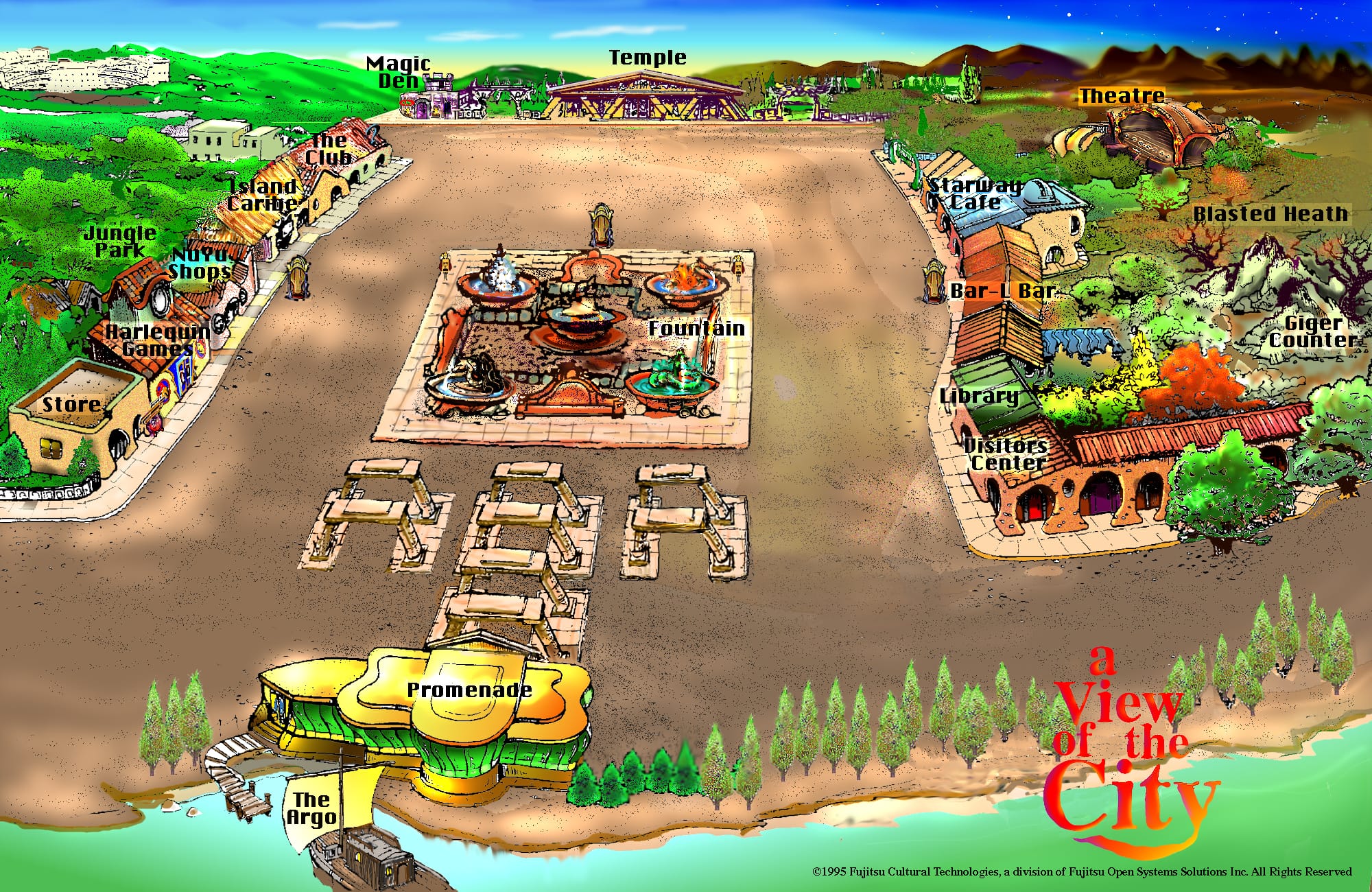
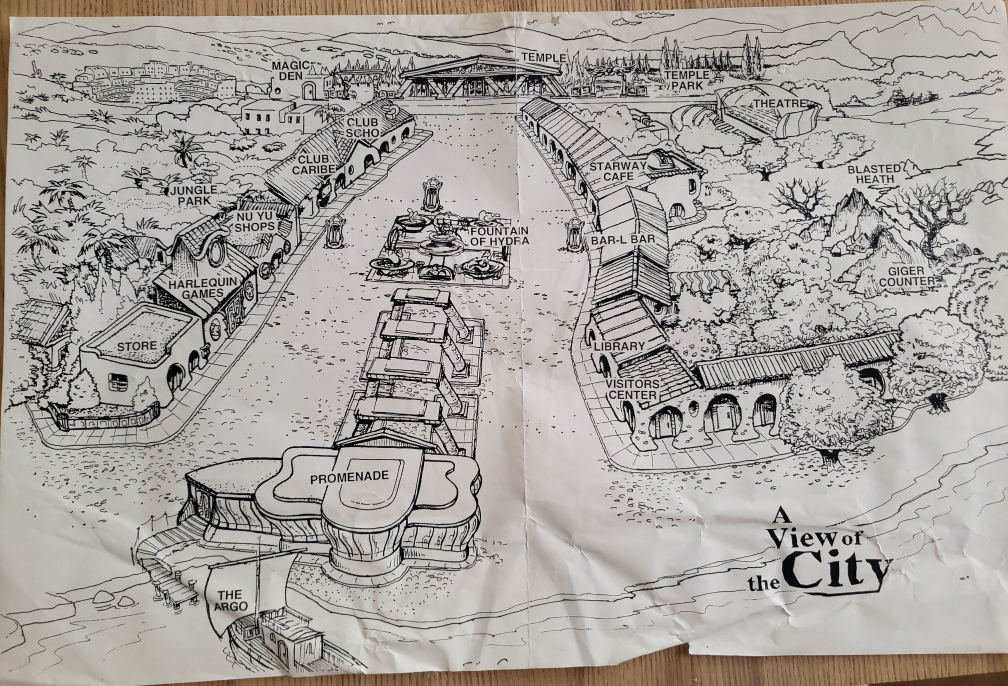
There is a story behind the different versions of the Dreamscape map images. The ordeal with the maps made me angry. The first has the proper perspective of the city, and is thus useful as a map. The second is more artistic but is not correct. At the time the map image was being created, some other people had been brought on at the upper management level to help “guide” us. One of things they wanted done was to change the promenade into a Flintstone’s-like building on the map. It didn’t matter that it didn’t match was was already there. In the end, I lost the battle for the map and the final version had the incorrect perspective and wrong promenade. But I won the war; they didn’t last long (or at least as long as I did).
The Temple Park from the map was eventually created behind the wall and to the west of the Temple. There was going to be an entrance, but it was scrapped.
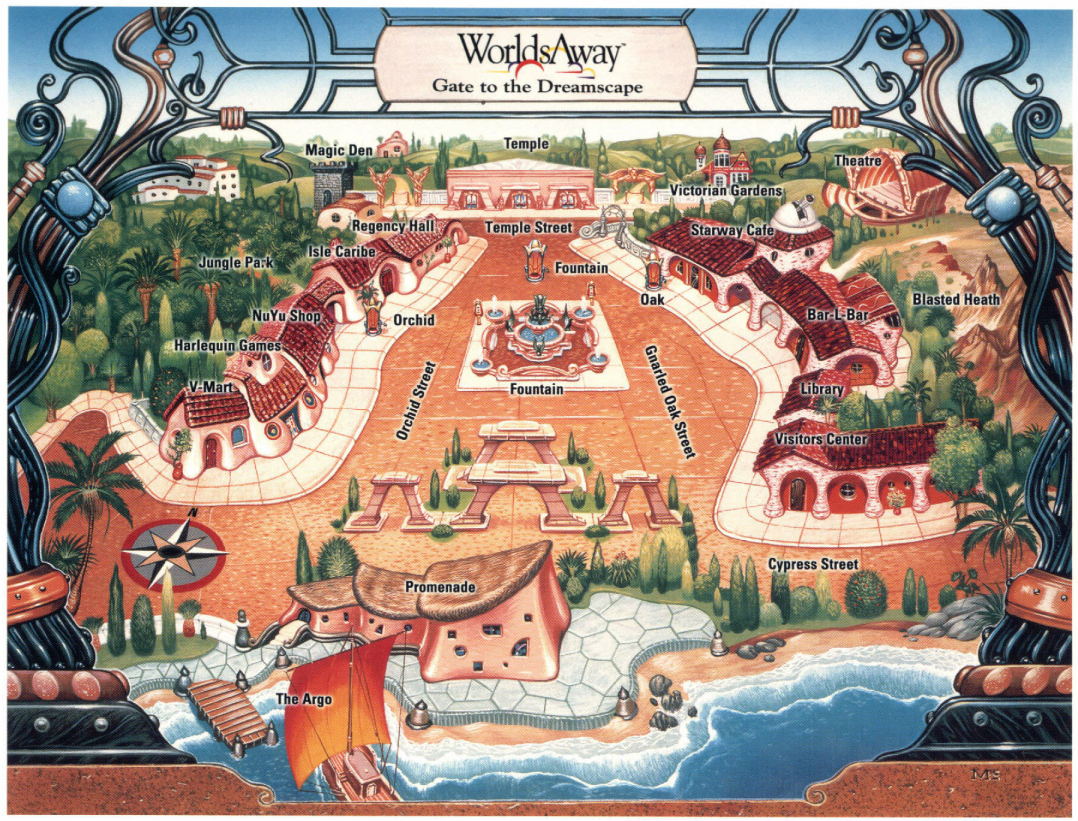
There were lots of things created and not used. As the service and the city evolved, things changed. There was a Hitler head that was deemed inappropriate. The Shit head didn’t go over so well, either. Some pieces of art were processed incorrectly and we never went back to fix them.
One of the areas I started working on was a bar in the Blasted Heath called the Geiger Counter. You could only get to it via a secret tunnel under in the Bar-L Bar cellar. It was to be a preview of what was coming in the Blasted Heath. In fact, now that I’m thinking about it, it’s possible I put the door in there and no one ever found it. You should check it out. Maybe it’s there?
The Geiger Counter (originally “Giger Counter”, after the artist H.R. Giger) was really the brainchild of Sheryl Knowles, our massively talented art director. We would have a world development meeting, brainstorm ideas, and then a few days later she and her artists would deliver a bunch of art to me. It was great.
Here is a list of unscheduled, upcoming events from 17 December 1996:
- Kymer Olympics
- Release Documents (Engineering Build - Jan 6th, 1997)
- Release Magic
- Oracle Bears
- Newlywed Game
- Private Club (Regency?)
- Giger Counter
- Temple Dungeon
- Bar-L Bar Cellar (path to Giger Counter)
- Starway Cafe Redesign
- V-Mart Redesign
- Storytelling: Proteus
- Storytelling: Dream Gates
- Storytelling: Morpheus and Hermes
- Kymer Museum of Legendary Artifacts
- Jungle
- Web Access Access to Dreamscape
Sadly, in March of 1997, the list wasn’t all that different…
When Phobetor and the Blasted Heath never took off, Teresias did what he could to send it into high gear upon his exit from the Dreamscape. You should ask him about that.
As we have already established, you were the first Oracle brought onboard the "Reno" project. When and how were Teresias and Uni recruited and did you train them?
When I ended up doing more Producer work than Oracle work, it was clear I needed help. I called Scott Moore (Oracle Teresias), a colleague of mine who I had worked with a Logitech in the support department. He had also worked with me on some live action roleplaying games.
Bringing him on was the best decision I made at Fujitsu. Scott joined the team in May of 1995. Randy had either already left or was just working a few hours, so I guess you could say I trained Scott, but honestly we were learning things together as we went along.
He immersed himself in the world (technological, mythological and sociological), and soon after was helping me decorate the world, by hand. Scott invented the method of using Post-it Notes stuck to the screen to measure out 3 pixels here or 2 pixels there.
When Beta hit, we worked together defining the Acolyte program and he ended up managing that aspect of the service. (Thanks to Scott for refreshing my memory here!)
Janet LeValley (Oracle Uni) was recommended by Norman Morse. She was another great decision. I wouldn’t characterize Janet as being “computer savvy”, but she had a PhD in psychology and an intuitive empathy beyond anyone else I’ve known. She brought a lot of skill and understanding to the team.
Scott and I took Janet under our wings, so to speak, but she ended up flying on her own easily. She immersed herself in the mythology and the culture. In many ways, she embodied The Dreamscape.
When I needed something for the world, all I had to do was ask her and she delivered, always exceeding expectations. “Janet, we have a couple that wants to get married – I need a marriage ceremony.” Boom, a deeply moving ceremony appeared on my desk. “Janet, we finally got a random number generator, I need a Dreamscape Tarot Deck.” A full deck based on the Dreamscape mythology appears a day later.
Do you still talk to any of the former or current staff of the Dreamscape?
Absolutely! Scott and I still hang out and talk. When I left Fujitsu to join Electric Communities, I brought him with me (albeit belatedly). I tried to get him to join me at There.com, but he wouldn’t bite. Considering how things turned out, he chose wisely. It was he who provided the lead to my current position at the Skoll Foundation.
Janet I’ve spoken with on and off. In fact, she just IM’d me. She’s living an adventure in Sri Lanka. She’s just amazing. Despite the gaps in our correspondence, I consider her a very close friend. She was really there for me when I needed her.
People from Fujitsu kept showing up at Electric Communities for work, so I talked with the team all the time. I’ve lost touch with most of the staff, although I chat with someone every once in a while.
I hear from Dreamscape Acolytes once in a great while. Same with Dreamscape members. But I have to be honest: there was a long time after I left that I really didn’t want the contact or exposure with anything Dreamscape, and I’m sure I offended a lot of people by just not responding to them. If anyone one reading this was one of those people, please accept my apology!
It was my decision to leave, but in some ways I wish circumstances had been such that I could have chosen to stay. I am very proud of The Dreamscape and because of the personal investment I made in the product and the people, leaving was not easy.
What was closed beta like? Obviously it was just you and selected members of FSBA staff but what happened in there? Any stories to tell or experiences that are either good or bad?
Now you’re really taxing my memory. A lot of the time was spent fixing annoying problems, like the placement of objects and backgrounds.
Just to clarify (in my own mind, at least), Closed Beta started [don’t recall]. Gates opened for open Beta started 4 August 1995. General Release started [10 September 1995]. I’m probably confusing what happened during closed and open betas, but we had an application form and closed beta included people other than Fujitsu staffers.
By the way, our company had several different names. Our division was called Cultural Technologies, but we worked for Fujitsu Open Systems Solutions, Inc (FOSSI). Then we worked for Fujitsu Systems Business of America (FSBA) and then Fujitsu Software Corporation. (I think in that order.) I’m pretty sure the big wigs were playing hot potato with our little division.
Editors note: It was actually Fujitsu Open Systems Solutions, Inc, then Fujitsu Software Corporation and finally Fujitsu Systems Business of America.
What was open beta like? I've heard many things about it but never actually experienced it, I also heard many of the former Club Caribers and people from Habitat went there. Did they or their previous worlds influence you in any way?
Habitat and the previous worlds were obviously a big influence. Club Caribe was created as an homage to Caribe on Q-Link. The NuYu is carried over as well. Randy had always planned on having a NuYu in every world he created (and there was one in Microcosm, which never launched). Honestly, though, The Dreamscape was my first virtual world, so any influences came directly through Randy.
Actually, when I saw WorldsAway for the first time, I was disappointed. Doom had been out and because of my work in the EVR group at Logitech, I was seeing the cutting edge of gaming technology on a daily basis. When WorldsAway was described to me, I envisioned a 3D world like Doom with social interaction. Well, we obviously got the socialization right, but it took a little while to pound the VR stuff out of my head.
Now in 3-D!
By F. Randall Farmer
(Published in Wired magazine, January 1996, page 117)
3-D isn't an interface paradigm.
3-D isn't a world model.
3-D isn't the missing ingredient.
3-D isn't an inherently better representation for every purpose.
3-D is an *attribute*, like the color blue.
Any time you read or hear about how great 3-D is and how it's going to change *everything* about computers and services, substitute the word *blue* for 3-D.
What I remember most is being in world 20 hours a day, just watching and learning how people used the system. I’d leave work, go home and log in. Teresias slept in his cube more than once. I was almost always a ghost, because the Oracles would instantly disrupt whatever was going on if they appeared. We tried to be respectful to what the avatars were doing.
One of the things we were most interested in was identifying Acolytes. When the gates opened on 4 August 1995, we spent a lot of time observing avatars who were natural Acolytes. The question we were most asked was, “How can I be an Acolyte.” The answer was always, “To be an Acolyte you must be an Acolyte.” This never went over very well, but it was true. The first Acolytes were identified because performing the duties of an Acolyte just came naturally and they did it without having to be asked.
Chameleon was the first Acolyte. Here is an excerpt from Teresias’ Oracle Report, dated 9 August 1995:
7:30pm: The following avatars may be considered for Acolyte:
Chameleon
Saberthooth
JWFriendly
Data
Libra
10:45pm: Chameleon performed the Acolyte ceremony and was given 1000T to use in duties. She is very eager … she does not wish to use any of her tokens for herself and, in fact, hunted me down to pay back a 100T gift.
11:40pm: Found out that Oracles can send ESPs to those even blocking ESPs.
12:00am: Acolyte Chameleon gets a page about a dispute.
Looks like it didn’t take long for poor Chameleon to be put to the test!
The first Acolyte I anointed was Libra on 11 August 1995. From a document dated 30 August 1995, the first group of Acolytes were:
From Community:
- Brynne
- CaribeLynx
- Chameleon
- Data
- Electra
- Indigo
- JWFriendly
- Libra
- Milen
- Moria
- Mysteria
- Nicci
- Rosaleah
- Sabertooth
- Serena
- Tulip
- VIQer
Recommended:
- Angus McSnarf
- Earendil
- Ravenwhyte
Ravenwhyte became and Acolyte shortly thereafter. Earendil turned down the position.
I wasn’t surprised Earendil turned it down. Being an Acolyte wasn’t all fun and games. Often, it could be more trouble than it was worth. There’s something to be said for being helpful just because you like it and on your own terms and schedule.
(On a side note, I still remember Ravenwhyte’s real-world visit. I kept him and Mary Madaras up all hours going to Goth clubs and staying up watching The Crow on laserdisc. Let’s just say I was going through my dark phase back then...)
Our theory of conflict management was based greatly on the spiritual teachings of Morihei Ueshiba, the founder of Aikido. The fundamental belief of Aikido is that if you meet aggression head on, you will lose strength and be overpowered by the attack. Instead, you deflect and redirect your opponent and use his energy against him.
From the Acolyte Handbook:
"The Art of Peace is based on Four Great Virtues:
Bravery, Wisdom, Love, and Friendship, symbolized by
Fire, Heaven, Earth, and Water."
- Morihei Ueshiba, The Art of Peace
These are what the four Fountains of Hydra symbolize.
From the Acolyte Handbook, on using Acolyte powers:
"In the Art of Peace we never attack. An attack is proof that one is out of control. Never run away from any kind of challenge, but do not try to suppress or control an opponent unnaturally. Let attackers come any way they like and then blend with them. Never chase after opponents. Redirect each attack and get firmly behind it."
- Morihei Ueshiba, The Art of Peace
We were not above borrowing from any mythology of spiritual teaching we found compelling and fitting within the overall story of The Dreamscape. We liked Nietzsche, too:
"The good four: Honest with ourselves and with whatever is friend to us; courageous toward the enemy; generous toward the vanquished; polite - always: that is how the four cardinal virtues want us."
- Friedrich Nietzsche
Our basic strategy was one of conversion. Take a troublemaker and convert him into a believer and you’ll have yourself one of the most loyal customers you could imagine. It worked, too.
What was it like when you were going live on Compuserve? Was it a mad rush to try and keep the server stable and make sure everythings working A-Ok or did you just breeze through it?
Oh, a total breeze. Yeah, um, everything worked like a charm right out of the gate.
Once Dreamscape was available to all Compuserve customers, what did the reaction feel like when you saw all these newbies coming inworld and having people flock around you because you were the only ones in decent clothing <g>
Hah! You know, having Oracle robes was a pretty big decision. We really, really didn’t want to have anything an avatar couldn’t have. We were against flaunting power and showing off. The fact that avatars were, well, let’s say “limited” in their choices made us think hard about whether or not we should don those robes. In the end, we decided it was important enough to the mythology of The Dreamscape and dressing like everyone else would actually take away from the customers’ experience. We really felt for the common avatar, but empathy only buys you so much. :-)
We made up for it though; Oracle bodies didn’t have any gestures to begin with. I think maybe we could <jump> and flutter up in the air, but that was it. Avatars at least had a full spectrum of gestures. Here’s a picture of Teresias trying to fly for the very first time.
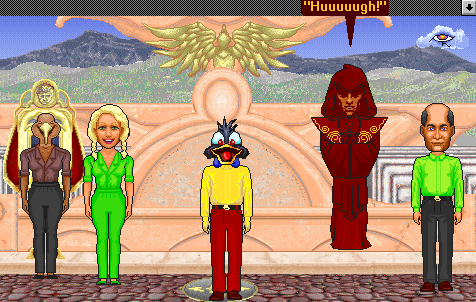
What was the deal with Turfs? Is there an interesting story as to why we went turfless for so long back in the early days?
What was the deal with Turfs? Is there an interesting story as to why we went turfless for so long back in the early days?
Unfortunately, the answer is “No, there isn’t an interesting story.” At least not as to why turfs took so long. We simply announced them too early and development took too long.
However, the effect on the community was fascinating! The fact that people carried on in-world protests was intriguing to us. On one hand, it showed the commitment of our customers. On the other, it had to be the least effective way to protest something we could think of. You see, during the time before turfs came out, our usage statistics actually went up! People were spending more time in Dreamscape than they would if there wasn’t a protest. We used to joke, “Let’s hold turfs off another month and get the numbers up.” (Please let me emphasize that this was joke. We never purposefully held up turfs.)
This also taught us that we needed more activities. I think one of the reasons the protests had such a high turnout was because it was the only thing to do. <g>
I have to admit, I did get tired of the war cry “No Turfs, No Peace”. I used to think, “C’mon folks, we’re on your side here!”
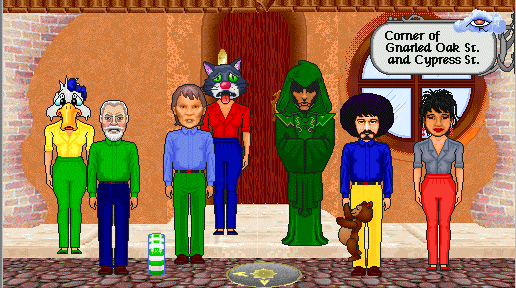
What was the deal with Charles Faulter PhD? Was that acting or did the porter really send someone to the Void? <g>
Charles Faulter was good fun! Because we had some rampant head stealing, we needed to come up with a way to punish the thieves. We could have just banned people from the service, but what fun is that? We learned from Randy and Chip’s experiences with Habitat and decided to create a Void and work it into the mythology of the world.
So, we created the storyline of a mad scientist trying to break through to a new area in Dreamscape. We spread it out over several weeks and made an event of it. Dr. Faulter would come and add a new bit of contraption to the teleporter and blather on like a mad scientist. When he finally got it to work, the experiment went awry and he was sent to the void, lost forever.
This gave us an in-world way to deal with troublemakers. Not only does this make the world more interesting, it helps immersion (dealing with in-world problems in the world) and it drives up usage. After all, it’s better to have troublemakers spending time in the world than not, as long as they’re separated from the rest of the community. <g>
Oh, I played Charles Faulter, PhD.
Shortly before the Jungle opened Tim Lavalli (Brother Echo) was brought onboard the team. How did that go down?
Simple: we were short handed and needed help! Janet (Uni) recommended him and so we hired him. I think it was his idea to not start out as an Oracle because it didn’t make sense within the mythology of Dreamscape.
Tim (Echo) was great. He “got it” right away. I left pretty soon after he started, so I didn’t have the opportunity to work with him as much as Scott and Janet.

Who's idea was it to sing "In the Jungle" at the Jungle Opening event :P
Oh, I wish I could remember the name. The truth is, someone in the forums (on Compuserve) started the rumor that when the jungle opened, the Oracles were going to sing “In the Jungle.” This was long before we even had plans to open the jungle and we thought it was hilarious!
Scott (Teresias) never forgot (he doesn’t forget anything) and months (years?) later, when it came time to open the jungle, he said, “Let’s do it.” So we did. Uni got the lyrics (this was before Google, folks) and we setup scripted the show.
Unfortunately, we never found out if the person who started the rumor ever knew we did it. If you’re out there, that song was for you!
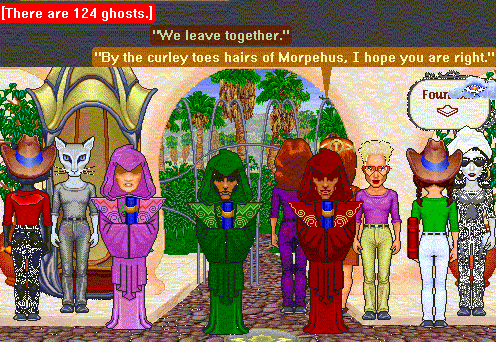
How do you think people viewed you as an Oracle?
Greenly?
I think the answer to that is subjective. Some people thought we were wonderful. Some thought we were pretentious asses. We were probably both.
Because we were responsible for running the service, it was a love/hate relationship. I had it better than Teresias, though. He played bad cop to my good cop. The strategy worked well, but people were probably more endeared to Oracle Vaserius.
Uni is another story. She really became the embodiment of the Dreamscape and I think she was universally loved.
I tell you though, I never felt more like a rock star than I did during the first gathering I attended. Uni was speaking and when she announced that Vaserius and Teresias were there (we had crashed the gathering) and we stood up, cameras flashed like it was the red carpet. Thanks to everyone who was there – you really made us feel special!
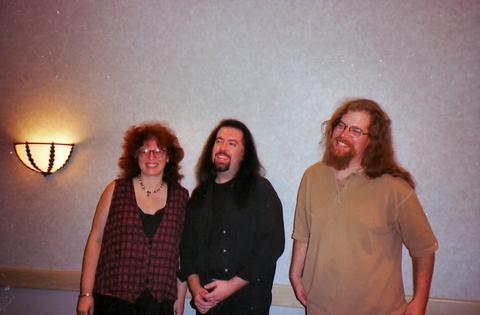
During your time in Phantasus what were your favorite moments? What did you enjoy most about the Dreamscape?
My favorite time was when we first let people in for beta. We were all excited, our energy was up and our dedication was 100%. We met the people who would be the foundation of the Dreamscape. We learned SO much those first weeks and months.
After that, they are all small, treasured moments. An interaction with someone when no one else was around; the first wedding and the creation of the vows; coming up with storylines like Charles Faulter or the alien abduction of Tony Christopher. I really liked working with the artists on new locales. They were so talented and creative.
The thing I enjoyed most was talking to members one on one. I would go in, sneak around, and drop in on someone and just talk. Or an old friend would IM me and we’d go somewhere secluded and chat. It was that interaction with people who truly cared about Dreamscape that made it worthwhile.
The hardest time I had was during Christmas. We created Kymer Kringle and members would come up and tell him their Christmas wishes. We created the candy land locales and the Oracles took shifts playing Kymer Kringle, who only spoke in goofy rhymes. I greeted people with things like, “Ho ho how you doing?”
What we weren’t prepared for were the wishes. Sure, most people wished for a new head, or a turf, or just played along with the general goofiness. But a few people shared their most sincere, deepest wishes. Things like, “My mom is really sick and I wish she will live through Christmas so we can spend the holidays with her one last time.”
I was taken completely off guard. What do you even say to that? I certainly didn’t have any canned answers in my macro list for things like this. All I could do was be honest and sincerely respectful and hopeful.
The thing is, it happened again and again. When it did, the mood in the cave (our offices) changed pretty quickly. The hardest part was you still had 4 hours of your shift to go and you had to play the goofy (and now seemingly inane) Kymer Kringle for everyone while inside you were deeply affected by what you were hearing and feeling.
I had always believed in the Dreamscape, but after that first Christmas, I knew we had something really, really special.
My most cherished time was the week before my departure. The outpouring of love and emotion from the community during my fountain walks was beyond touching. The Oracles and Acolytes had a private party in the temple dungeon, and while it was mostly a celebration, it’s still hard to read the transcripts. When it comes to reading the final ceremony when Oracle Vaserius leaves, forget about it – I still can’t.
Leaving was very difficult. The emotions that came up were something I didn’t expect and wasn’t prepared for. I think I went into a sort of self-imposed exile from all things Dreamscape. So if you wrote to me back then and didn’t get a response, I apologize. It wasn’t personal, it was just too much for me at the time. I had to let go in order to move past it. Even still, Dreamscape still tugs at my heart.
Finally, wrapping everything up... are you proud of the fact that the Dreamscape made it to it's tenth year and is still going strong?
When I started at Fujitsu Cultural Technologies, and probably for the next year or two, if someone would have said, “You know, what you’re creating here will still be running in 10 years,” I would have answered, “Of course it will!” I was young, ambitious, and I so, so strongly believed in Dreamscape.
However, near the end of my tenure, after a year of documents not being released and fighting about in-world advertising and not having a technology upgrade, my answer would have been slightly different.
I never thought Dreamscape would die because of the community, though. I always thought the community was strong enough. I just didn't think the service could survive the turmoil of changing ownership or survive not having the platform updated in a decade. I think it might be the only live service that is supported on a 486. <g>
For all the rancor over changes and new owners (and I had me share, believe me), we should at least be thankful that someone came along and saved the service. I doubt Fujitsu would have kept it running.
But now that Dreamscape has lived to see its 10th anniversary, I am extremely proud! Out of everything I’ve done, the work we did on Dreamscape is what I’m the most proud of. I’m glad we were able to create a place that attracted the kind of people who now call Dreamscape home, but it is the community, the dreamers, that should be proud. The Dreamscape is here 10 years later because of YOU.
Dream well,
- Vaserius
